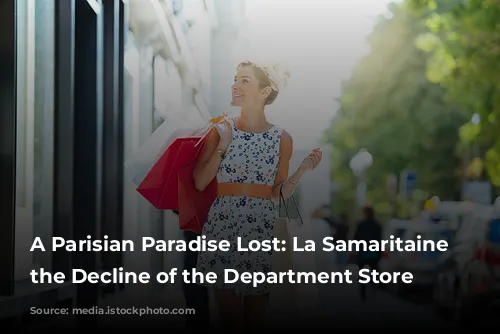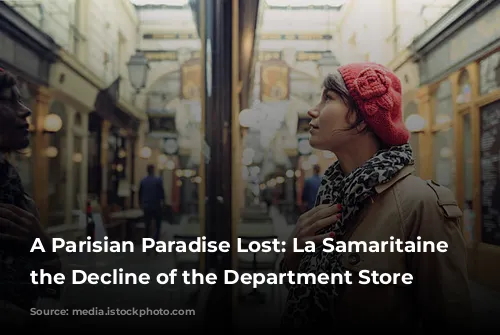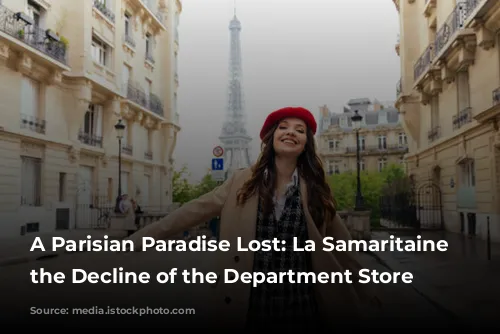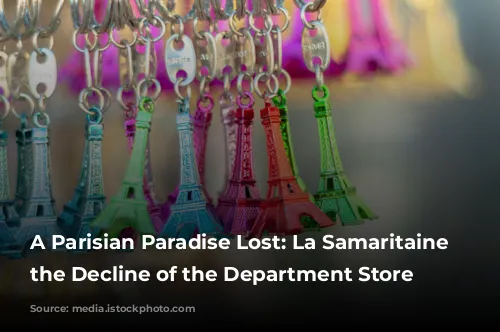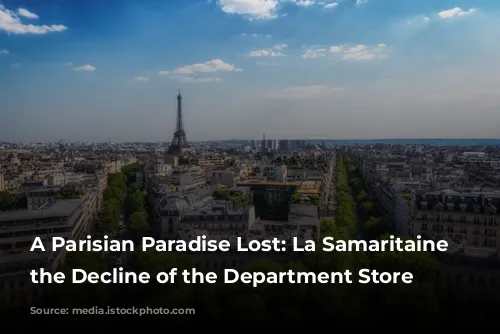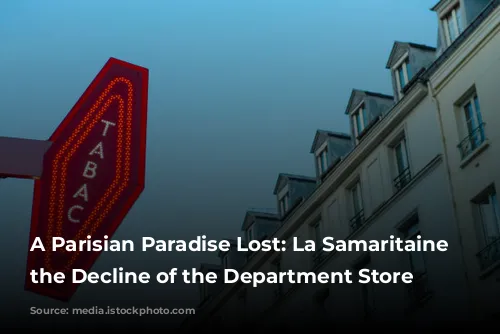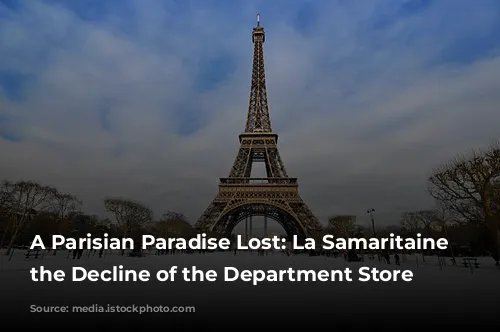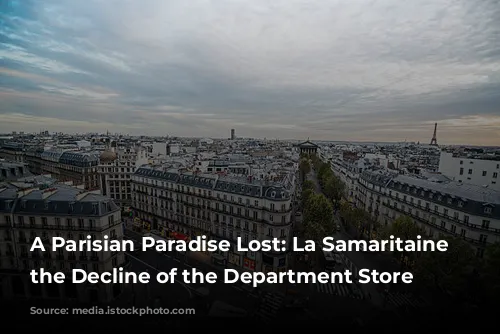Imagine a Parisian rooftop adorned with beach chairs, a digital sunset casting a glow over an artificial ocean, and a futuristic “beauty light bar” promising radiant skin. This is the world of La Samaritaine, a department store reborn in the heart of Paris. However, there’s a stark contrast between the grandeur of its design and its disappointing reality. The grand halls, once bustling with shoppers, now stand eerily empty, reflecting the dwindling fortunes of department stores worldwide.
The once vibrant “find everything” emporium, established in 1870, was acquired by the luxury conglomerate LVMH in 2001. After a controversial 16-year, €750 million renovation by renowned Japanese architects, the department store reopened in 2020, now boasting a luxurious five-star hotel. Despite the ambitious transformation, La Samaritaine struggles to attract customers, with only occasional tourists snapping photos of the building’s iconic art nouveau atrium.

A Wistful Glance Backwards: The Golden Age of Department Stores
The empty halls of La Samaritaine stand as a stark reminder of the department store’s changing fortunes. Today’s desolate shopping landscapes are a far cry from the bustling grand magasins of old. The Musée des Arts Décoratifs, nestled near the deserted floors of La Samaritaine, offers a glimpse into the department store’s glorious past. It’s a nostalgic journey, celebrating the birth of a building type and cultural phenomenon that revolutionized urban life. But could this historical reflection hold the key to the modern department store’s revival?
The world’s first department stores were captivating spectacles. Giant lithographs in the exhibition showcase their opulent interiors, boasting gilded chandeliers and grand staircases, a testament to the grandeur of the era. These retail palaces, born out of the economic boom of Napoleon III’s reign, were designed to impress and entertain. Located in the heart of the city, they were more than just stores; they were social hubs for the burgeoning bourgeoisie, a stage for the rising social elite to flaunt their wealth and status.

Crafting the Culture of Consumption: The Rise of Marketing and Fashion
The department store wasn’t just a place to shop; it was an experience. They were havens of leisure, offering an escape for women from their domestic confines. They were designed to encourage lingering, promoting a sense of freedom and indulgence. It was a world of extravagance captured in Émile Zola’s novel, “The Ladies’ Paradise.” The stores treated customers like guests, fostering a welcoming atmosphere, devoid of the pressure to buy. This shift in perception was revolutionary. The department store’s success was built on this unique blend of retail and social experience.
The stores were masters of product display, using theatrical techniques to ignite desire. They created entire worlds around their merchandise, showcasing the latest fashion trends, home décor, and everything in between. The department store was a one-stop shop for creating a complete lifestyle, catering to the aspirational desires of the burgeoning bourgeoisie. The emergence of ready-to-wear fashion, fueled by the mechanization of textile production, further cemented the department store’s influence. Advertising posters, featuring the iconic “La Parisienne,” an embodiment of chic and independence, cemented Paris’s position as a global center of style.
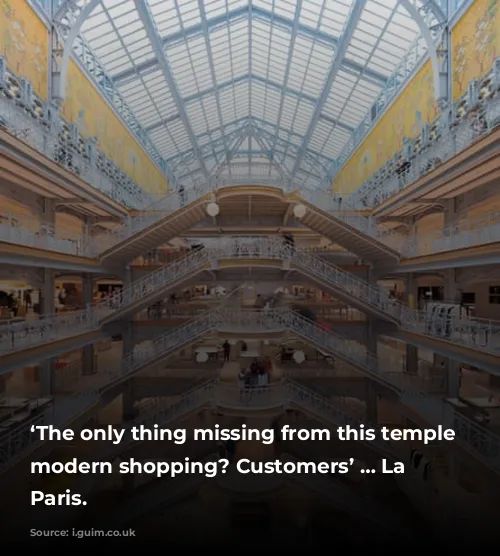
From Catalogues to Fast Fashion: The Evolution of Retail Strategies
Department stores mastered the art of persuasion, using innovative marketing techniques to entice customers. They developed a strategic sales calendar, with monthly promotions across various categories, from linens to toys. Advertising campaigns fuelled these sales periods, creating a sense of urgency and encouraging shoppers to keep up with the latest trends. This strategy laid the groundwork for fast fashion, with the department store becoming a platform for showcasing the latest fleeting trends, an early ancestor of the modern online fashion giant, Asos.
The department store’s reach extended beyond its walls. The invention of the mail-order catalogue opened up a new world of shopping possibilities. Intricately illustrated catalogues, featuring everything from umbrellas to bicycles, were delivered to homes across the country, bringing the department store experience directly to consumers. This early form of e-commerce paved the way for subscription-based services like Amazon’s “Subscribe and Save,” showcasing the department store’s adaptability and foresight in anticipating consumer needs.

A Legacy of Consumption: Examining the Dark Side of the Department Store
The Musée des Arts Décoratifs offers a fascinating journey through the history of the department store, but it’s a story tinged with a darker side. The department store’s legacy is intertwined with the rise of consumerism, a culture of acquisition, and the birth of sophisticated marketing techniques. It is where the relentless pursuit of more and more became a defining characteristic of modern society. The exhibit’s section on “Children As the New Target Market” is particularly jarring, highlighting the early emergence of targeted advertising aimed at children.
The department store’s rise coincided with a period of unchecked industrialization, fueled by a relentless drive for profit. The exhibit’s focus on the department store’s contribution to mass consumption provides a stark reminder of the environmental and social consequences of our relentless pursuit of acquisition. The history of the department store is a story of progress and innovation, but it’s also a story of unintended consequences. The exhibit offers a glimpse into the environmental challenges posed by mass production and consumption.
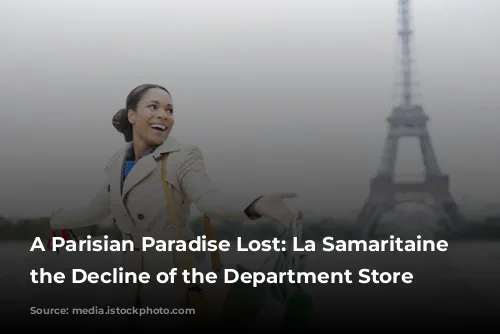
Reimagining the Department Store: A New Era of Urban Spaces?
While the department store’s heyday may be over, it leaves behind a rich legacy of innovation and cultural influence. Its demise prompts us to consider the future of urban spaces. Can we learn from the past and envision a new era of public spaces that go beyond the pursuit of consumer goods? Could these once grand palaces of consumption be transformed into vibrant centers for learning, creativity, and community? The success of expanded libraries across Europe offers a glimpse into the potential for repurposing these iconic buildings. Perhaps the department store’s legacy lies not in its role as a purveyor of goods, but in its potential as a catalyst for a new era of urban revitalization.
